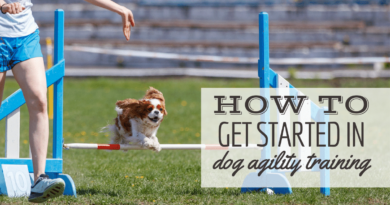6 Reasons Why Your Dog is Hyper – Top Dog Tips
Dog zoomies occur naturally within the canine realm, called Frenetic Random Activity Periods (FRAPs).
These actions refer to the random yet unmistakable explosions of energy a dog might have on occasion.
These activities often include a dog running in circles or spinning in circles.
Other dogs may parkour over the furniture or bounce up and down repeatedly.
While there may be no real cause for these actions, the sudden bursts of energy may serve a purpose.
What Do Dog Zoomies Look Like?
These actions are a common experience for domestic dogs, namely city dogs.
Although every pet will experience these actions differently, extreme energy is most common in domestic dogs within the city.
Many experts believe the activities start with being socially, physically, and mentally pent up.
Every pet will experience zoomies differently, but extreme energy is the most common symptom.
These actions include running in circles, sprinting, or making a play bow to attract friendly interaction.
Pups will commonly race erratically with their tail between their legs and their back rounded.
Understanding Why Zoomies Happen
The scientific name for dog zoomies is frenetic random activity periods (FRAP), and they’re, unfortunately, just another part of canine behavior.
Dog zoomies typically occur when a canine is happy and excited, remaining harmless overall if it happens occasionally.
The actions do serve a real purpose: it releases pent-up energy.
Too many zoomies, however, may signal that your dog requires more mental or physical stimulation than you currently provide.
Although zoomies can occur regardless of how much exercise your pup receives, it’s more likely to happen if the dog hasn’t had good outlets for the energy.
6 Common Reasons a Dog Gets the Zoomies
Virtually every dog will get the zoomies at some time, regardless of age, size, or breed.
Younger dogs and puppies will show these actions more frequently as they have more energy to burn compared to older dogs.
Senior dogs can still get zoomies, but it will likely be less common. Frequently, dogs will have FRAPs at specific times.
While experts and veterinarians can’t wholly determine why a canine gets zoomies, here are a few probable reasons:
Release Anxiety or Tension
Many dogs will experience an intense level of activity shortly after bath time, which is likely a way for them to lower anxious energy.
If there’s an event that’s caused stress or excitement, zoomies can help the dog regulate the emotion and to relieve tension.
Celebrating a Feel-Good Moment
While humans are programmed to contain emotions, dogs are much simpler mentally.
Many pet parents notice their dogs will get zoomies after relieving themselves.
Unloading a full bowel is enough for many dogs to have a bizarre celebration. Likewise, a dog with some poop stuck to them can react similarly.
Although this action might seem similar to traditional zoomies, it’s probably not the same.
Acting on Primal Instincts
Zoomies often happen around the same time of day, stemming from the animal’s built-in biological rhythm.
Most dogs will have a regular burst of energy in the morning and during the evening hours, which likely relates to natural hunting rhythms.
For instance, a coyote will hunt during dusk and dawn as prey will be more vulnerable.
Relieving Pain or Annoyance
Dogs will almost always associate zoomies with a positive event. Occasionally, these actions could stem from sharp and passing pain in the hind area.
As a result, your dog tries to run and escape the pain. If your dog is experiencing arthritis or flea bites, it may spook your pup with randomly passing pain.
Effective Way to Warm Up
A dog that spends time outside may come into the house and run around. Your dog may be trying to warm up after spending time in cold environments.
If you notice your dog regularly has zoomies after the afternoon stroll, consider purchasing a coat or sweater to keep them warm.
Dogs may also have higher energy levels when getting out of the lake, pool, or other body of water.
Showing Excitement
When your furry companion faces something exciting (whether a person or pet), they can’t contain their excitement.
Zoomies are a unique way to show how happy, excited, or engaged the pup is with the current situation.
Medical Reasons for Zoomies
Despite zoomies being normal behavior, there are a few medical reasons for these sporadic FRAP episodes.
Here are a few medical reasons your dog might have a case of zoomies and what you can do to help him.
Cushing’s Disease
Cushing’s disease occurs when your dog’s adrenal glands create too much cortisol, a steroid hormone released in response to stress.
One of the most common symptoms of this disease is excessive panting.
While panting after playtime is expected, when your dog hasn’t been stressed, in the heat, or playing excessively, it could be caused by Cushing’s disease.
Other symptoms include:
- Going to relieve themselves more
- Weight gain
- Muscle weakness
- Hyperpigmentation (darkening of the skin)
- Increased appetite and thirst
- Potbelly appearance (or large and inflated stomach)
Diagnosing Cushing’s Disease
Most veterinarians will begin with bloodwork and an examination to diagnose the disease. Treating the condition starts with oral medication, along with other therapeutic effects.
Although Cushing’s disease is manageable, the average life expectancy after diagnosis is three to six years.
Arthritis in Joints
When your pooch starts showing signs of arthritis, it can be challenging to watch the progress.
Difficulty getting up, tiring quickly, or seeming stiff after sleeping are signs of something more happening.
The most common culprit of canine arthritis is a degenerative joint disease or osteoarthritis.
Osteoarthritis starts when the cartilage protecting the bones of the joint is destroyed.
As the joint loses its cushion, friction between the bones causes pain and decreased mobility. Symptoms of the condition include lameness, stiffness, and limping.
There are several different approaches to minimizing arthritic aches and pains, including medical and non-medical tactics.
Adequately managing arthritic pain reduces inflammation, along with reducing painful spasms that may lead to zoomies.
Kidney and Liver Disease
Early symptoms of this condition include vomiting and diarrhea, loss of appetite, weight loss, and changes in behavior.
Unfortunately, the symptoms of early-stage liver disease are non-specific, which may occur with several ailments. This overlap in illnesses makes detecting liver issues difficult.
As toxins accumulate, the body struggles with getting rid of them, as the liver would have typically eliminated them. Occasionally, neurological problems can occur with later-stage liver disease.
These symptoms include a lack of coordination, aimless wandering, disorientation, and pacing.
Treatment of liver disease includes many different options, from surgery to medications. Frequently, antibiotics can eliminate bacterial infections, while fluid therapy can treat or prevent dehydration.
Although preventative measures don’t always protect against liver and kidney disease, they can lessen the probability of it occurring.
Here’s how to lower the chance of your pup getting liver and kidney disease:
- Never let your dog drink from unclean or stagnant water sources. These sources may contain blue-green algae and mold, which causes acute liver failure.
- Maintain your pet’s weight to avoid illnesses like diabetes.
- Avoid giving your dog over-the-counter medications like Advil or Tylenol without consulting a veterinarian.
- Keep harmful substances out of your dog’s reach. These substances include medications, pesticides, antifreeze, and dangerous foods.
- Always follow instructions for administering medication to your dog.
Age-Related Dementia
Canine Cognitive Dysfunction is a cognitive disorder associated with similar effects of Alzheimer’s in humans.
Traditionally, the condition relates to the aging of a dog’s brain, leading to behavior changes.
When your senior dog suddenly begins displaying curious behavioral changes or failing to remember basic household routines, it may suffer from dementia.
Symptoms may vary, depending on the condition, but often include disorientation, confusion, and anxiety. It also includes aimless wandering or changes in the sleep cycle, like night waking.
While the early signs of canine dementia are challenging to detect, it’s critical to identify mild symptoms before they become severe.
The exact cause of canine dementia is unknown, but chemical and physical changes and aging processes influence brain function.
Although keeping your dog physically and mentally active may prevent dementia, the exact cause is still unknown.
How to Control Dog Zoomies
It’s critical to understand that zoomies are a natural part of canine behavior. There isn’t a reason to prevent or discourage the actions as long as your dog is in a safe space.
The safe space might include your home or fenced yard, preferably away from small children, breakable objects, or elderly individuals who could become knocked over in the process.
Try to avoid letting your dog zoom around on hardwood floors or other slippery surfaces whenever possible.
Although it might seem funny to watch your dog slide across the floors, it can become dangerous as the animal could slip and injure himself.
Instead of trying to control if and when the dog has zoomies, control the environment he zooms.
For instance, anyone that understands the dog gets the FRAPs after grooming or bath time can take their dog by the leash (or carried, if small enough) to a yard or room where he can safely run around.
Never Chase Dogs with Zoomies
Unfortunately, there are times when FRAPs occur, and it’s not just inconvenient; it’s outwardly unsafe.
Dogs experiencing zoomies frequently forget their surroundings and refuse to act on any training.
Whether you’re trying to prevent the dog from trampling over houseguests or stopping them from running into traffic, catching the dog quickly becomes a priority.
Despite seeming counterintuitive, it’s crucial not to chase a dog with the zoomies. Chasing the dog, even if it appears to be in danger, may instinctively start his play drive.
Once the dog’s play drive starts, he’s likely to continue the behavior, including running away from you.
What To Do Instead of Chasing the Dog
To get your dog back under control, run away from your dog, encouraging him to follow you in a cheerful voice.
Use your dog’s name and a high-pitched dialogue to engage the animal.
It’s always a good idea to have a few high-value treats or toys for your dog in this situation, especially when you need to get your dog away from threats or danger.
If your dog starts with the FRAPs inside, consider moving the dog immediately outdoors if you have a safe fenced area for him to run.
Moving the dog outside may not stop the behavior, but it can redirect the energy into an environment better suited for running.
To prevent these actions from happening, consider what started the episode and how you might prevent or reduce it from happening in the future.
Trying to Prevent Dog Zoomies
As these behaviors are normal and standard, owners don’t need to do anything to stop the actions.
If you’re unhappy with the dog running around your home frantically, consider redirecting the actions outside.
Alternatively, offer higher activity levels throughout the day if you notice the dog continuously has the same response.
Dogs won’t zoom around the house if they are physically tired throughout the day. Exercise is a simple way to prevent or limit zoomies.
Likewise, mental stimulation can help prevent outbursts throughout the day.
Spend a few minutes throughout the day to tire the dog mentally and physically. Activities include training exercises, walks throughout the neighborhood, and playing with other animals.
Dog Zoomies: Conclusion
Although it might seem bizarre, FRAPs are typically a healthy and natural part of canine behavior.
Although zoomies are considered normal canine behavior but often occur during inopportune times, redirecting the behavior and recognizing any triggers that start the actions are the easiest ways to handle the bizarre and sudden bursts of energy.
To limit the frequency of zoomies, ensure your dog has plenty of time to engage in physical and mental stimulation throughout the day.
If your dog shows other concerning symptoms, talk to your vet for further investigation. They can help you diagnose symptoms and correct any ongoing ailments.
A vet can also confirm whether your dog’s zoomies are healthy behavior too.
READ NEXT: 25 Most Common Dog Behavior Issues: Habits and Problems That Are Not Normal










